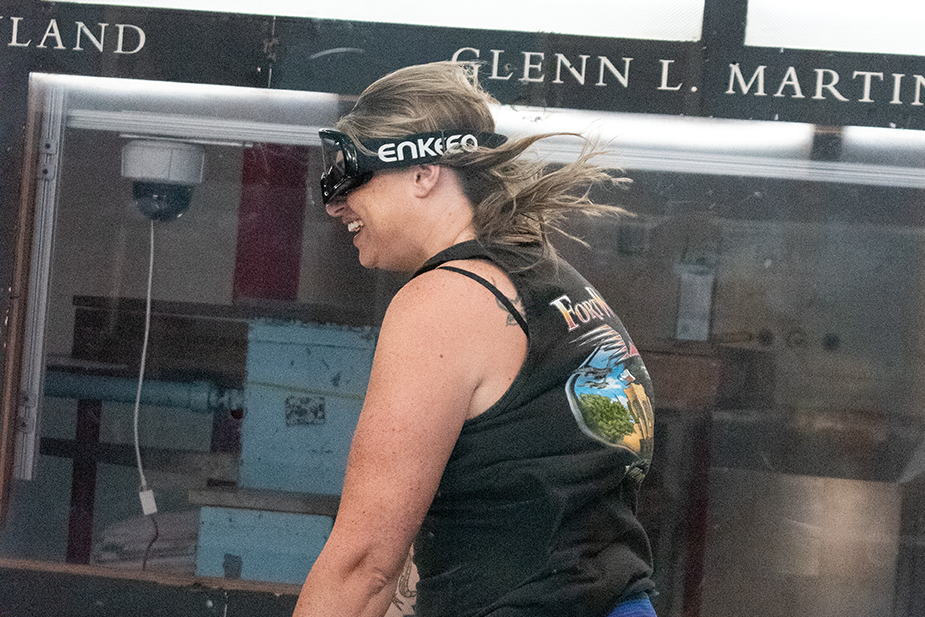 |
![Meteorologist Steve Sosna of Baltimore's CBS affiliate, WJZ-TV, braved hurricane-strength winds at UMD's Glenn L. Martin Wind Tunnel. [Photo: Ambi Narula]](http://mnemosyne.umd.edu/tomcat/newsengine/articleImg/article16180.large.png)
|
 |
Meteorologist Steve Sosna of Baltimore's CBS affiliate, WJZ-TV, braved hurricane-strength winds at UMD's Glenn L. Martin Wind Tunnel. [Photo: Ambi Narula] |
|
In the summer of 1988, as Hurricane Gilbert cut a destructive path through the Caribbean, CBS sent its national Pentagon correspondent to the University of Maryland’s (UMD) Glenn L. Martin Wind Tunnel (GLMWT) for a first-hand experience of hurricane-force winds.
More than three decades later, concerns continue amid an ongoing increase in severe weather events. On Tuesday (July 16), meteorologist Steve Sosna of Baltimore's CBS affiliate, WJZ TV, followed in the footsteps of his network colleague, donning goggles and a harness as the GLMWT equipment generated a breeze that soon ramped up into a 115 mph blast of wind.
Along with WJZ-TV, Krishna Sharma and Kaitlyn Newman from The Baltimore Banner also took the opportunity to test their powers of endurance.

The Baltimore Banner photojournalist Kaitlyn Newman experiences high-velocity winds generated at the GLMWT, which can achieve wind speeds of 230 mph. [Photo: Ambi Narula]
Built in 1949 with support from aviation pioneer Glenn L. Martin, the GLMWT has been used for decades to test rotorcraft blades and conduct other forms of aerodynamic research and development. Each year, during hurricane season, media are invited to tour the facility, speak with disaster resilience experts, and experience the terrifying power of a hurricane—safely.
Colin Vissering, a UMD civil and environmental engineering doctoral student affiliated with the Center for Disaster Resilience, said data from wind experiments can help resilience experts devise effective ways to mitigate the risks posed by extreme weather events.
Such research translates into building codes that have made communities better able to withstand hurricanes, Vissering told The Baltimore Banner, noting that pre-1960s buildings are significantly less safe because they were not built to such codes.
The GLMWT has conducted more than 2,300 tests for over 300 distinct clients. With a speed range of 2 to 230 mph (Mach Number 0 to 0.3), winds in the GLMWT are generated by a large 2,250 HP electric motor, driving propeller blades originally used on B-29 aircraft. Over the last 30 years, the facility has regularly been used to test automobile aerodynamics, including almost all of the Ford Motor Company's scale-model tests.
In addition, it has hosted tests for planes—from ultralights to jet fighters to commercial airliners—and other airborne vehicles and devices, including helicopters, missiles, and parachutes. It has also seen its share of more unusual vehicles, including a hovercraft and the Pride of Maryland solar-powered car.
In tne Media
"A rare look inside UMD’s historic wind tunnel will blow you away," Baltimore Banner, July 20, 2024
Related Articles:
UMD Resilience Experts Offer Insights Throughout Active Atlantic Hurricane Season
National Media Highlights UMD Hurricane Research, Wind Tunnel
July 25, 2024
|

